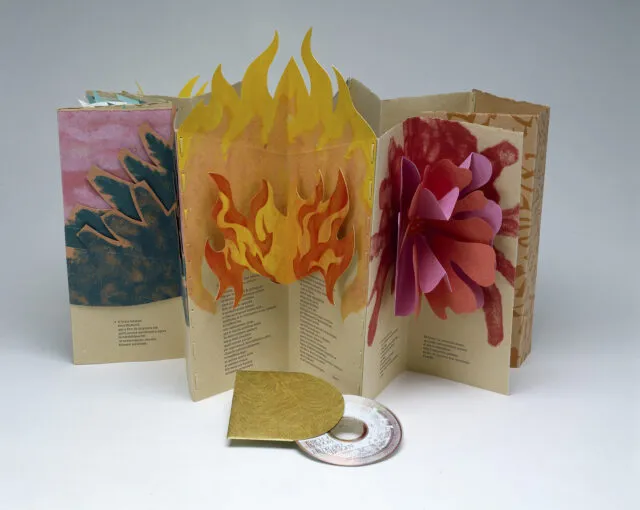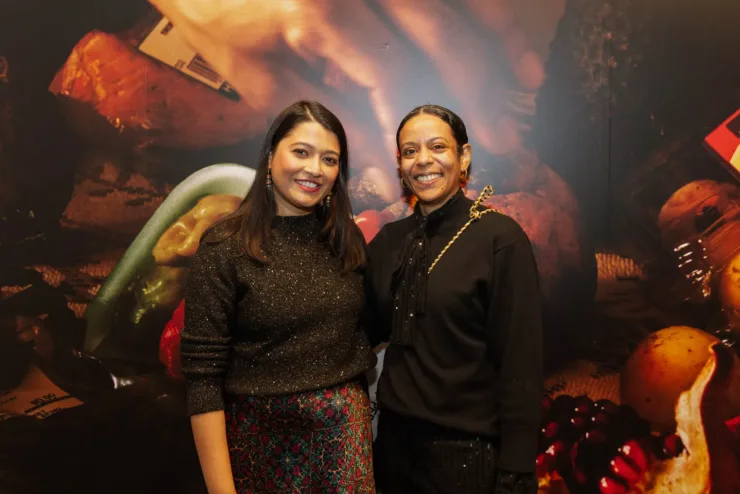Key Connections
Visual Arts
- An artist’s book is an art form that uses elements of traditional book structures such as covers, binding, and pages.
- An artist’s book is a three-dimensional work of art and is meant to be viewed from multiple sides.
- The shape and format of an artist’s book reflects its meaning.
- The materials used to create an artist’s book help convey its meaning.
- Most artists’ books are meant to be handled by the viewer.
Writing
- The text of an artist’s book complements the meaning of the artwork.
- The presentation of the text (its design and placement on the page) reflects the meaning of the words.
- Any style of writing can be included in an artist’s book such as single words, poetry, stories, phrases, etc.
Instructional Objectives
Visual Arts and Writing
- Students will understand that artists’ books convey meaning through their use of form, materials, and text.
- Students will understand that artists can use a variety of materials to create artists’ books and that artists’ books can be almost any size and shape.
- Students will understand that artists’ books can include almost any kind of text.
- Students will compare a traditional book form to an artist’s book and note similarities and differences.
- Students will add text and images to their flag books.
Instructional Plan
Observe
View one or more of “The Book as Art” online exhibitions featuring artists’ books in the museum’s collection. Each of the seven exhibitions highlights a different book format. Begin by asking students to describe and define books. What is a book? What is the purpose of a book? What are the parts of a book? Use a traditional book to identify the parts of a book with students. Have students compare traditional books with the books they have already made in class. What is similar about them? What is different? How is a book like a sculpture? How is it different?
A Closer Look
Ask students to look carefully at Barton’s Tunnel Map and begin describing and interpreting what they see. Visual Thinking Strategies is a highly effective method for facilitating productive conversations about art with your students and introducing new vocabulary in a meaningful way. Following the conclusion of this initial exploration of the work, you may wish to revisit certain concepts in more depth using some of the questions in the Discussion section.
For additional artworks to include with this lesson, please view this art gallery. To learn more about the featured artists, check out Carol June Barton’s artist profile and Claire Van Vliet’s artist profile.

Discuss
- What is the shape or form of the book?
- Which parts of a book can they find? Is there a spine? Where is the binding? How many pages are in this book? Where is the cover?
- What materials did the artist use?
- Is there any text in the book?
- How can the book be read? Can it be read left to right or top to bottom? Is there more than one way to read it?
- What is the book about?
- How do the book form and its materials help you understand what the book is about?
Tell students that Tunnel Map is an example of an artist’s book.
- How is this book different from a traditional book? How is it similar?
- How is the book’s form part of its message?
- How is Tunnel Map different from a sculpture? How is it similar?
Ask students to look carefully at Claire Van Vliet’s Circulus Sapientiae. Use the same questions to guide their discussion for this artwork. Once they have described it, ask them to compare it to Barton’s Tunnel Map.
For additional discussion questions, download the full lesson plan.

Create: Decorate Your Flag Book
Supplies
- Student journals
- Students’ flag books made in Lesson 6
- Pens and pencils
- Drawing supplies
- Collage materials, such as various scraps of paper and found materials (optional)
- Glue sticks (optional)
Activity
Form and Content
- Have students work with the flag books they created in Lesson 6. Lead a short discussion about the flag book’s form and how it can be manipulated. For example, it can be read as if it has two pages (each made of three flags) or it can be pulled apart, separating the flags and allowing the viewer to see both sides at once.
- Ask students what kind of ideas and images the flag book form makes them think about.
- Ask students what styles of text might work well with the book form.
- Opening a flag book can be surprising. How can students make use of the element of surprise?
- Remind students they made this book form during the lesson on abstract art and that they can use this form to explore abstraction and the elements of art.
Add Images and Text
Ask students to use colored pencils, markers, watercolors, collage materials, or other art supplies to add images and text to pages and covers of their flag books.
Reflect
Have students respond to one of the following prompts in their journals.
- What questions do you have about artists’ books now that you didn’t have before?
- What would it take to change a book in a library to become an artist’s book in a museum?
- My flag book will surprise others because….
Go Deeper
Check out related writing objectives, lesson extensions, and more in the comprehensive PDF lesson plan.
Vocabulary
Artist’s book
An artist’s book is an art form that uses elements of traditional book forms in combination with the elements of art.
Book form
A book form is the shape and structure of a book. The parts of a traditional book include the binding, spine, covers, pages, and text.
Elements of art
Elements of art are color, line, shape, form, space, value, and texture. Artists use these tools to create all visual art: representational, abstract, and non-representational. (Review the vocabulary list for definitions of individual elements of art.)

